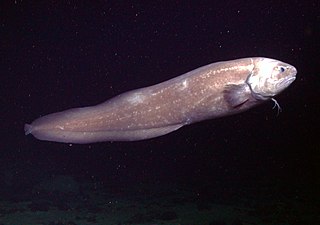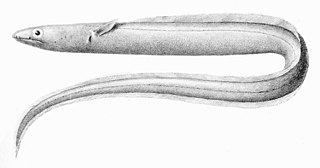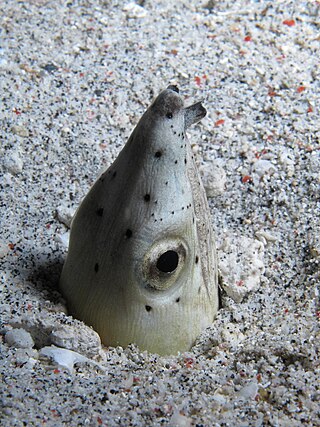
Ophichthidae is a family of fish in the order Anguilliformes, commonly known as the snake eels. The term "Ophichthidae" comes from Greek ophis ("serpent") and ichthys ("fish"). Snake eels are also burrowing eels. They are named for their physical appearance, as they have long, cylindrical, snake-like bodies. This family is found worldwide in tropical to warm temperate waters. They inhabit a wide range of habitats, from coastal shallows and even rivers, to depths below 800 m (2,600 ft). Most species are bottom dwellers, hiding in mud or sand to capture their prey of crustaceans and small fish, but some are pelagic.

The superorder Elopomorpha contains a variety of types of fishes that range from typical silvery-colored species, such as the tarpons and ladyfishes of the Elopiformes and the bonefishes of the Albuliformes, to the long and slender, smooth-bodied eels of the Anguilliformes. The one characteristic uniting this group of fishes is they all have leptocephalus larvae, which are unique to the Elopomorpha. No other fishes have this type of larvae.

The cusk-eel family, Ophidiidae, is a group of marine bony fishes in the Ophidiiformes order. The scientific name is from the Greek ophis meaning "snake", and refers to their eel-like appearance. True eels diverged from other ray-finned fish during the Jurassic, while cusk-eels are part of the Percomorpha clade, along with tuna, perch, seahorses and others.

Uropterygius is a genus of moray eels in the family Muraenidae.

Myrichthys is a genus of snake eels currently containing 11 recognized species found in tropical and warm temperate oceans worldwide.

Eels are ray-finned fish belonging to the order Anguilliformes, which consists of eight suborders, 20 families, 164 genera, and about 1000 species. Eels undergo considerable development from the early larval stage to the eventual adult stage and are usually predators.

Callechelys is a genus of eels in the snake eel family Ophichthidae. It currently contains the following fifteen species:

Echelus is a genus of eels in the snake-eel family Ophichthidae.

Ophichthus is a genus of eels in the snake eel family Ophichthidae.

Pisodonophis is a genus of eels in the snake eel family Ophichthidae. It currently contains the following species:
Yirrkala is a genus of eels in the snake eel family Ophichthidae. It is named after Yirrkala, an indigenous community in Arnhem Land, in the Northern Territory of Australia.

Ophidion is a genus of cusk-eels.

The goldspotted eel, also known as the goldspotted snake eel or the dark-spotted snake eel, is an eel in the family Ophichthidae. It was described by Charles Alexandre Lesueur in 1825, originally under the genus Muraenophis. It is a marine, tropical eel which is known from the western and eastern Atlantic Ocean, including Bermuda, southern Florida, USA; the Bahamas, Santa Catarina, and Brazil. It dwells at a maximum depth of 15 metres (49 ft), and inhabits rocky and coral reefs. Males can reach a maximum total length of 110 centimetres (3.6 ft).

The highfin snake eel (Ophichthus altipennis, also known as the blackfin snake eel or the black-finned snake eel, is an eel in the family Ophichthidae. It was described by Johann Jakob Kaup in 1856, originally under the genus Microdonophis. It is a marine, tropical eel known from the eastern Indian Ocean and northwestern and western central Pacific Ocean, including Australia, French Polynesia, Indonesia, Japan, the Marshall Islands, Malaysia, the Philippines, and Papua New Guinea. It dwells at a depth range of 0 to 40 m, and forms burrows in soft inshore sand sediments. Males can reach a maximum total length of 103 cm.
The longarmed snake eel is an eel in the family Ophichthidae. It was described by John E. McCosker and Richard Heinrich Rosenblatt in 1998. It is a marine, tropical eel which is known from the eastern central Pacific Ocean, including Mexico, Costa Rica, El Salvador, Guatemala, Nicaragua, and Panama. It is known to dwell at a depth range of 24 to 79 metres, and inhabits soft substrates. Males can reach a maximum total length of 27.4 centimetres (10.8 in).
The dottedline snake eel is a species of eels in the family Ophichthidae. It was described by John E. McCosker and Eugenia Brandt Böhlke in 1984. It is a marine, temperate water-dwelling eel which is known from the western central Atlantic Ocean. It is known to dwell at a depth of 183 meters.

The Blackspotted snake eel is a species of eel in the family Ophichthidae. It was described by Théophile Rudolphe Studer in 1889. It is a rare tropical, marine eel which is known from the western and southern Atlantic Ocean, including Bermuda, the Bahamas, the Lesser Antilles, Brazil, and Ascension Island. It is known to dwell at a depth of 12 meters, and inhabits sand and turtle grass; it forms burrows which leave its head exposed. Males can reach a maximum total length of 71 centimeters.

The Galapagos snake eel is an eel in the family Ophichthidae. It was described by David Starr Jordan and Charles Harvey Bollman in 1890. It is a marine, tropical eel which is known from the eastern central and southeastern Pacific Ocean, including Colombia, the Gulf of California, Costa Rica, the Galapagos Islands in Ecuador, and Clarion Island in the Revillagigedo Archipelago in Mexico. It dwells at a depth range of 3 to 80 metres, and inhabits reefs, preferring to live in areas bearing a mixture of boulders, gravel and sand. Males can reach a maximum total length of 71 centimetres (28 in).

The smallfish snake eel is an eel in the family Ophichthidae. It was described by Charles Henry Gilbert in 1890 as a marine, tropical eel which is known from the eastern central Pacific Ocean, including Mexico, Nicaragua, Panama, the Gulf of California and Costa Rica. It dwells in shallow waters at a maximum depth of 20 metres (66 ft), and inhabits sand and rock sediments. Males can reach a maximum total length of 70 centimetres (28 in).
Quassiremus polyclitellum is an eel in the family Ophichthidae. It was described by Peter Henry John Castle in 1996. It is a marine, temperate water-dwelling eel which is known from New Zealand, in the southwestern Pacific Ocean. It dwells at a depth range 35 to 58 metres, and inhabits rocky surfaces. Males can reach a maximum standard length of 79.5 centimetres (31.3 in).
















